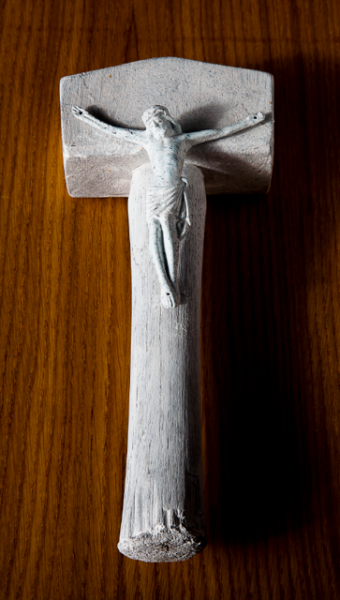News
Wed 06 Mar 2013
Mum Man
Mum Man’ – Shaun Doyle and Mally Mallinson
Private View: 21 March 6 – 8pm / Exhibition: 22 March – 27 April 2013
Paul Stolper Gallery is proud to present Shaun Doyle and Mally Mallinson’s ‘Mum Man’ an exhibition of bronze and mixed media sculptures, prints and works on paper that offer an unfettered account of contemporary Britain. For nearly 10 years, Doyle and Mallinson have incorporated humour and cynicism into their work, censuring behaviours and values associated with contemporary society that they consider untrustworthy, suspect or corrupt. The title ‘Mum Man’ comes from a friend of the artists’ who addressed everyone as ‘man,’ ending every sentence with the word. The title was chosen as it not only suggests a nickname for early hominids like ‘upright man’ but also as it references a change in the social role for men. Doyle and Mallinson’s first solo exhibition at the gallery is a satirical account of the British experience, with three distinct, yet coherent groups of work; the ‘Handyman’ bronzes, the ‘Ecce Homo’ works, and the ‘Wendy Squats’.
The ‘Handyman’ bronzes include three sculptures; The ‘Shovel of Sorrows’, the ‘Handyman of Sorrows’, and the ‘Hammer of Sorrows’. The works all reference the Medieval image of the Man of Sorrows, a violent depiction of Christ impaled by tools of labour, which was used as a warning against labouring on the holy Sabbath. The level of violence inflicted on Christ, common in the art of the period, remains in Doyle and Mallinson’s contemporary version, titled ‘Handyman of Sorrows’. The sculpture depicts Christ pierced with the tools of the Sunday DIYer, revealing a shift in narrative within society, as Sunday is now seen as a day of manual labour, with DIY replacing worship and B&Q becoming the new Church. The sculpture, in polished bronze, is also reference to the finely worked reliquaries found in early Christian art, the polished surface and detailed craftsmanship seeks to make something beautiful out of the barbaric. What seems at first to be a contemporary anti- Christian work is proved to be a re-working of a very pro-Christian icon, re-contextualizing and recycling an apparently redundant image from the Church’s past.
The ‘Ecce Homo’ works, namely ‘Ecce Homo Tesco’, the ‘Ecce Homo Suite’ of drawings, and ‘Homo Tesco (Bin Boy)’ all explore an imaginary branch of human evolution. ‘Homo Tesco (Bin Boy)’ depicts a skeletal figure clothed in a shopping bag, perched on a bin, clutching a rusty can opener. In this offshoot from the hominid family tree, Homo Tesco has evolved extended arms from shopping bag dragging and exists in a post apocalyptic world where family groups survive on so called value food and ready meals. The ‘Ecce Homo Suite’ of works on paper continues the artists’ speculation of specie groups, taking it to absurd lengths. Each Homo Erectus is overdrawn, modified and named to create a new hominid, highlighting the media’s penchant for creating stereotypes and ‘groups’ so that society can be neatly ordered. ‘Homo Disco’, ‘Home Chavo’, ‘Homo Anarchisto’ and ‘Asda Man’ all reflect the social, cultural or political forces that could have influenced the evolution of these ‘might have beens’. They are also speculative in the sense that human evolution has not reached any conclusion and Doyle and Mallinson’s ‘reconstructions’ are just as likely to have come from an article in The Sun as the New Scientist.
Finally, the ‘Wendy Squats’ explore the idea of ‘the home’ as something suspect. Interpreted in previous incarnations as a comment about the current economic and housing crisis, the ‘Wendy Squats’ also describe the vulnerability that any personal, national or cultural identity might seem to offer by way of security. Typically the home is something that is associated with security but this, along with notions of identity and hierarchy, are liable to change or collapse. Referencing also the artists’ experience of squatting and the knowledge that one man’s ruin is another’s castle, the kiddie playhouse is now boarded up and abandoned, as though the previous dwellers have packed up and moved on. The house becomes a relic, suggesting a disinheritance of previously held family values. The home is often used as a metaphor for the human head, and if the house is a state of mind, the ‘Wendy Squats’ are bankrupt, its ideology exhausted and derelict, representing a social structure that needs to be abandoned.
Shaun Doyle and Mally Mallinson have exhibited internationally at institutions including Rude Britannia, Tate Britain; Autumn Exhibitionists, Institute of Contemporary Arts, London and Teenage Kicks – Ca plane pour moi, Galerie Clarke, Montreal. Solo shows include Peristroma Dolorosa, MOT International, London; Return to the Black Forest Ghetto, Galerie Nostheide-Eycke, Dusseldorf, Germany and Ecce Homo Erectus, Venlo Stadhuis, NL. The artists live and work in London and Uttoxeter.
31 MUSEUM STREET LONDON WC1A 1LH +44(0)20 7580 7001 paulstolper.com info@paulstolper.com
